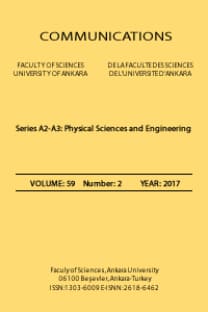INTERPOLATION METHODS FOR RECOVERING THE SAMPLING VALUES OF GPR DATA
Ground Penetrating Radar (GPR), Sampling Value, GPR Data, Underground Structures (Anomalies), Incomplete Data, Interpolation Methods
___
Annan, A.P. 2009. Electromagnetic Principles of Ground Penetrating Radar. In Ground Penetrating Radar: Theory and Applications, edited by Harry M. Jol, pp. 3-40. Elsevier, Amsterdam.Benesty, J., Chen, J., Huang, Y. and Cohen, I. 2009. Pearson correlation coefficient. Noise reduction in speech processing. Springer Berlin Heidelberg, 1-4.
Bristow, C.S. and Jol H.M. 2003. GPR in sediments: advice on data collection, basic processing and interpretation, a good practice guide. Geological Society: London, Special Publication 211; 9-28.
Cassidy, N.J. 2009b. Electrical and Magnetic Properties of Rocks, Soils and Fluids. In: Ground Penetrating Radar: Theory and Applications, edited by Harry M. Jol, pp. 41-72. Elsevier, Amsterdam.
Conyers, L.B. 2004. Ground-Penetrating Radar for Archaeology. AltaMira Press, Lanham. Dojack, L. 2012. Ground Penetrating Radar Theory, Data Collection, Processing, and Interpretation: A Guide for Archaeologists, 7-9.
Dojack, L. 2012. Ground Penetrating Radar Theory, Data Collection, Processing, and Interpretation: A Guide for Archaeologists, 7-9.
Leckebusch, J. 2003. Ground-penetrating Radar: A Modern Three-dimensional Prospection Method. Archaeological Prospection. Vol 10; 213-240.
Levinson, N. 1947. The Wiener RMS (root mean square) error criterion in filter design and prediction.
Maeland, E. 1988. On the comparison of interpolation methods. Medical Imaging. IEEE Transactions 7(3), 213-217.
McKinley, S. and Megan, L. 1998. Cubic spline interpolation. College of the Redwoods 45(1), 1049-1060.
Meijering, E. and Michael, U. 2003. A note on cubic convolution interpolation. IEEE Transactions on Image Processing 12, 477-479.
Ozkan, M. and Samet, R. 2017. Interpolation Techniques to Recover the Incomplete GPR Data. In: The 16th International Conference Geoinformatics, Kiev, Ukraine.
Safont, G., Salazar, A., Rodriguez, A., Vergara, L., 2014. On Recovering Missing Ground Penetrating Radar Traces by Statistical Interpolation Methods. Remote Sensing 6, 7546-7565.
Samet, R., Çelik, E., Şengönül, E., Tural, S. and Özkan, M. 2015. Interpolation approach to search hidden result in GPR data. In: The 5th International Conference on Control and Optimization with Industrial Applications, Baku, Azerbaijan. 422 –425.
Samet, R. and Özkan, M. 2016. Incomplete Data Production Methods in GPR Research and Applications. In: The 15th International Conference Geoinformatics, Kiev, Ukraine.
Samet, R., Çelik, E., Tural, S., Şengönül, E., Özkan, M., Damcı, E. 2017. Using interpolation techniques to determine the optimal profile interval in ground-penetrating radar applications, Journal of Applied Geophysics (140), pp. 154-167.
Zhao, W., Tian, G., Forte, E., Pipan, M., Wang, Y., Li, X., Shi, Z., Liu, H., 2015. Advances in GPR data acquisition and analysis for archeology. Geophysical Journal International 202, 62-71.
- ISSN: 1303-6009
- Yayın Aralığı: Yılda 2 Sayı
- Başlangıç: 2019
- Yayıncı: Ankara Üniversitesi
INTERPOLATION METHODS FOR RECOVERING THE SAMPLING VALUES OF GPR DATA
A NEW SIMILARITY COEFFICIENT FOR A COLLABORATIVE FILTERING ALGORITHM
Ozge MERCANOGLU SINCAN, Zeynep YILDIRIM
Entropy squeezing of a multi-photon Jaynes-Cummings atom in the presence of noise
SENTIMENT ANALYSIS USING A RANDOM FOREST CLASSIFIER ON TURKISH WEB COMMENTS
Nergis PERVAN, Hacer YALIM KELEŞ
Ozge MERCANOGLU SINCAN, Hacer YALIM KELES, Yagmur KIR, Adnan KUSMAN, Bora BASKAK
DETECTION OF MUSCLE FATIGUE: RELATIVE STUDY WITH DIFFERENT METHODS
Mohamed REZKİ, Abdelkader BELAİDİ, Mouloud AYAD
